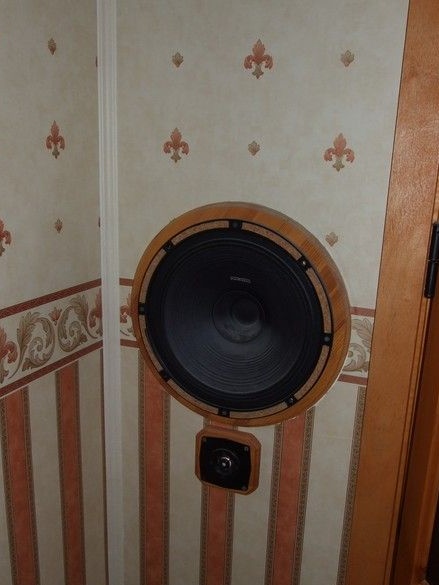
Among hams, the maxim is popular - “the best transmitter is the antenna!”. In sound reproduction, speakers, if not the best amplifier, then the contribution to the overall sound is very significant. And as with a good antenna, this is cumbersome and expensive. Thinking of assembling a "path" - a turntable-amplifier-acoustics, I decided on an amplifier. For various reasons, it turned out to be of very low power, which means that acoustic systems of sufficiently high sensitivity were required. The choice fell on the "cinema" 75GDSH33-16. I liked the parameters - power 75 W, resistance 16 Ohms. Ohmmmm. Such a hefty pan, I will report to you, but the sensitivity is pretty - 94 ... 96 dB. Domestic, of course, in Novosibirsk they do. In addition to the parameters, it is important that the head is broadband. On the one hand, of course, there is a narrowing of the range of reproducible frequencies, on the other hand, an extreme simplification of the design, since it is not so simple to make filters correctly.
Acoustic design. The bottom line is that the speaker cannot fully sound on its own - sound vibrations from the forward and backward movements of the diffuser are mutually attenuated and the efficiency of such acoustics is very, very small. These oscillations are required to be divided and quenched or inverted in phase inverse. This is achieved by various techniques, the implementation of which is called "acoustic design". There are not so many of them, the most common ones are “closed box”, “shield” or its more commonly used option “open box”, “phase inverter”. Each of the methods has both its inherent disadvantages and advantages.
The choice of acoustic design for a particular speaker, in addition, is not so great - each of them, by a combination of parameters, is approximately intended for a certain type of acoustic design. Well, the scope of use, so to speak, imposes ... In a word, the “closed box” design type was chosen, as the most radical, if not small in size, here it was also decided not to be stingy and execute the buildings as part of the living room and with a fair amount of good , the apartment was concrete walls, but the floor with the ceiling and construction and finishing work by us were just beginning.
So, the "closed box".Here they act decisively with unnecessary vibrations: locked in a confined space behind the diffuser, they sooner or later fade away and turn into heat. The amount of this heat is scanty, but in the world of acoustics everything is in the nature of small perturbations, so the way this thermodynamic exchange occurs is not indifferent to the characteristics of the speaker system. If you allow sound waves inside the loudspeaker housing to dangle unattended, a significant part of the energy will be dissipated by the volume of air contained inside the case, it will, although slightly, heat up and the elasticity of the air volume will change, and in the direction of increasing rigidity. In order to prevent this from happening, fill the internal volume with sound-absorbing fibrous material. Absorbing sound, this material (usually cotton wool, natural, synthetic, glass or mineral) also absorbs heat. Due to the significantly higher heat capacity of sound-absorbing fibers than that of air, the temperature increase becomes much smaller and the dynamics “seem” to have a significantly larger volume behind it than not actually. In practice, in this way, it is possible to achieve an increase in the "acoustic" volume in comparison with the geometric volume by 15 - 20%. This, and not at all in the absorption of standing waves, as many believe, is the main point of introducing sound-absorbing material into enclosed loudspeakers.
A variation of this type of acoustic design is the so-called “endless screen”. An endless screen is considered to be a closed box with a volume so large that the elasticity of the air enclosed inside it is much less than the elasticity of the diffuser suspension, so the speaker simply does not notice this elasticity and the characteristics of the acoustic system are determined only by the parameters of the head. Where the boundary passes, starting from which the box volume becomes infinite, depends on the parameters of the speaker. However, for comparison - in car audio, such a volume is always the internal volume of the trunk, which, even in a small car will give a reaction of "infinitely large" volume even for a large speaker.
Acoustic design has the following advantages - ease of calculation of characteristics. A closed box has only one parameter - the internal volume. And in the case of an "endless screen" it is possible at all, almost by eye - due to the dimensions. With a competent choice of the parameters of the head and volume for it, the closed box is unparalleled in the field of impulse characteristics, which largely determine the subjective perception of bass notes.
So, the design type and speakers are selected. A place in the apartment for the speakers was chosen and a decision was made to make them
buildings are “integrated” in the layout.
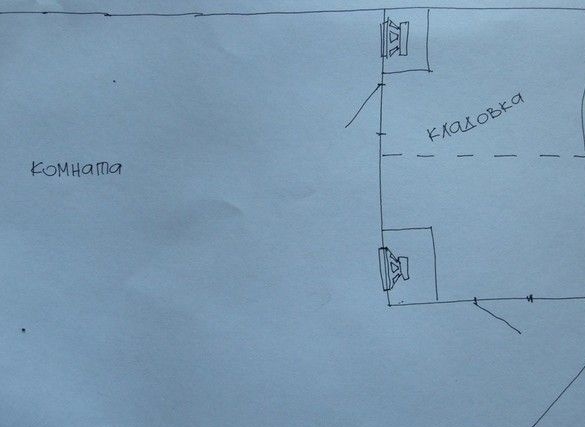
To navigate the area ... One-room apartment in a new building, about 60m2. The external walls of the room are concrete, everything inside is drywall. Make a box of speakers, it is also decided from drywall.
What was used at work.
Instruments.
Actually, the classic "guest worker set" - spatulas, brushes, rollers. Squeezer for sealant, step ladder. A screwdriver, a drill, a small angle grinder will come in handy. In some places, the hammer will not be superfluous. For wallpapering - roller, trough, special rollers for rolling. From the stand out from the list - a manual milling machine with snap "compasses".
Materials
In addition to the speakers themselves and drywall with special profiles, we needed wires, terminals for speakers, a lot of screws, acrylic sealant, roll insulation (mineral wool), a pine shield of a suitable size. It is clear - wallpaper for external pasting and glue for them, PVA glue for the primer or finished soil, containers, all sorts of related trifles.
So. The standard drywall pantry had to be disassembled thoroughly - in addition to purely architectural work, I also had to strengthen the wall and erect the speaker boxes.
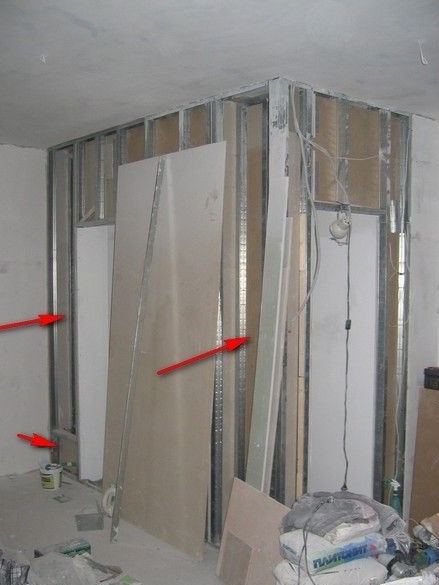
In the photo, arrows indicate the "integrated" cavity - the future speaker enclosures. The overall size of the boxes is about 500x300mm in section, well, from floor to ceiling - 2.75m.
All work was carried out with shtanny materials for the installation of drywall walls - tin profiles, fasteners. The walls of the buildings are double (in two layers) with careful gluing of PVA between the layers. Profiles, too, did not spare for the strengthening and struts. At the bottom of one of the boxes, a socket (a small arrow in the photo) was pulled out, and a small hermetic cavity had to be fenced off. The inner surface of the boxes was carefully primed, then in several layers it was smeared with acrylic sealant diluted with water. After drying, all corners were carefully coated with the same sealant.

Photo of one of the boxes from the closet itself. The small arrow shows the terminal block output location for both speakers. After laying the wires inside the cases and the walls, the inside of the boxes was partially filled with a loose layer of mineral wool.
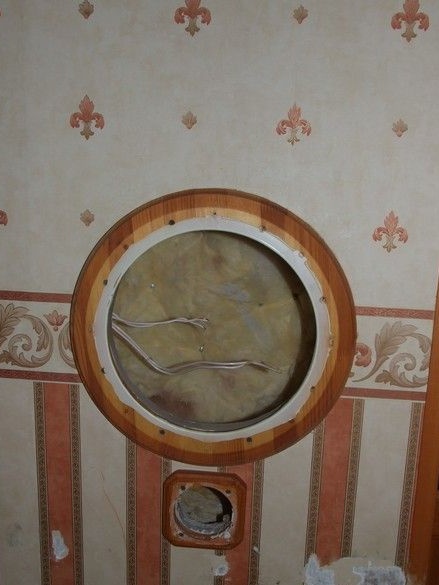
For fastening heavy speakers, flanges of a pine furniture board were made. A milling machine with a "compass". After several layers of varnish, installed on the sealant and a fair amount of screws. The length of the latter was chosen somewhat larger than the thickness of the wall of the speaker and their ends inside the cases, screwed into tin boxes. The photo above is a view after dismantling the speakers a few years later, for clarity.
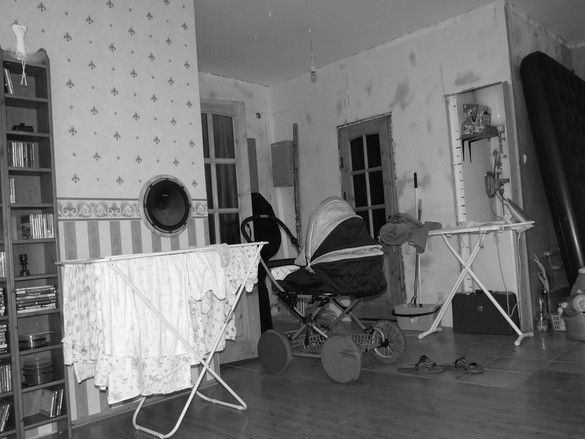
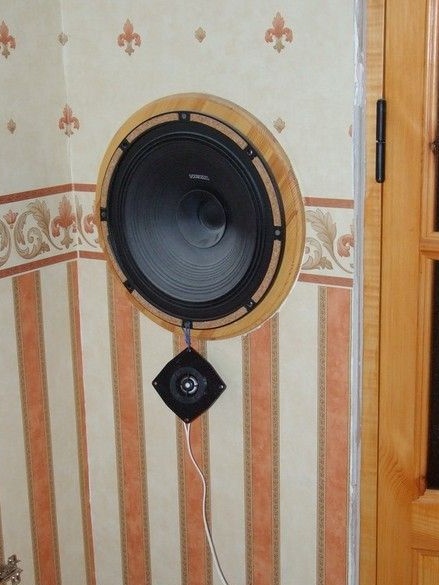
The speakers to the wooden flange were also fastened with screws through a layer of acrylic sealant.
After some time of operation, I decided to slightly modify the speakers by adding high-frequency speakers of suitable sensitivity and resistance.
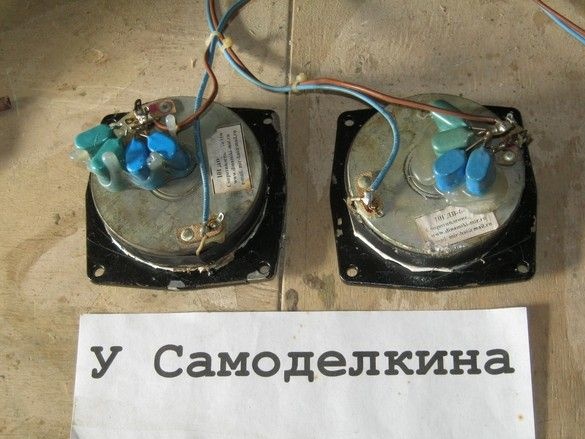
They were 10 GDV-6, the same NOEMA, with a simple filter from a capacitor.
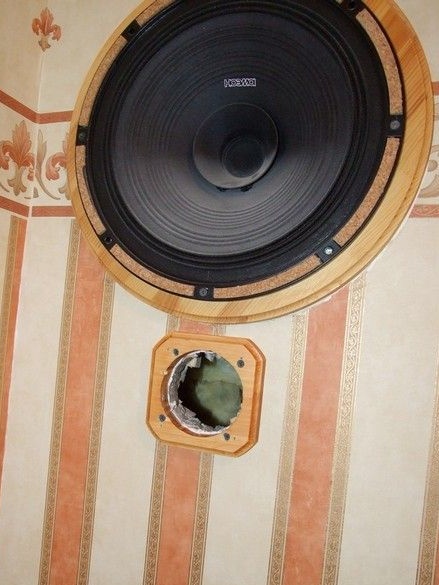
To fix the speaker, similar flanges were placed below the main speakers - the tweeters have a rather narrow radiation pattern and so they were at the level of the head of the person sitting in the chair.

Frankly, there was no significant expansion of the frequency range, but plates and brushes in jazz music became better heard.
In this form, the speakers worked for about five years, until we left the city. The quality of music playback turned out to be excellent, long listening was almost tiring, which indicates the absence of significant irregularities in frequency response. Instrumental measurements were not performed. The sensitivity of the speakers turned out to be excellent - the power of a tube amplifier of 0.8 W per channel was enough for a very high volume, right up to the neighbors' bumping on heating radiators. The bass was very good, without infrasound, but very dense and without any overtones. Fans of disco music might not have appreciated it, but jazz, rock and instrumental music sounded very good. The only significant drawback of the design is the impossibility of "placement" in the room, including remoteness from the walls. On the other hand, the room, still not a concert hall, but a one-room apartment of small sizes, had to come to terms with this.
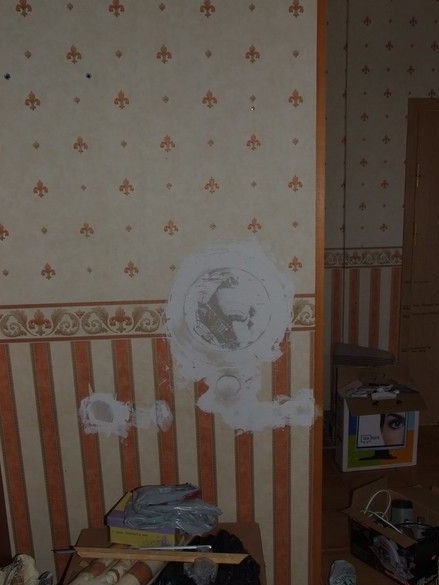
After moving and renting the apartment, on the next visit, during redecoration, the speakers were dismantled, the holes were patched up and glued with wallpaper. Here is a story of this unusual speaker system.

